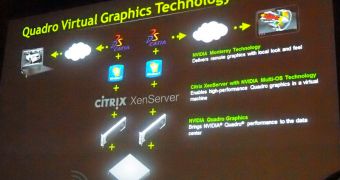The briefing that NVIDIA reportedly held at SIGGRAPH 2011 had the company outlining certain plans that mean to change the professional market's approach to graphics, complete with endorsement on the part of Autodesk and Adobe.
Even in the midst of Tegra preparations and driver conflicts with Apple's Lion operating system, NVIDIA has not lost sight of the professional market.
Normally, professional applications like graphics design and the like require substantial processing and GPU prowess.
NVIDIA, however, wants to change the approach into one where less formidable cards are favored, like “light Quadro GPU and as large a Tesla as you can get in the system,” as reported by the folks over at Engadget.
Then again, this is just part of what the Santa Clara, California-based company seeks to accomplish (project Maximus).
The other layer of its plans are gathered in something of an initiative all on its own, dubbed Virtual Graphics (which includes project Monterey) and has, as ultimate goal, the bringing of Quadro-level, app-agnostic graphics capabilities to anything with a decent Internet connection.
In other words, the outfit seeks to combine multiple technologies into something new, which is, essentially, the basis of all innovation.
Should Maximus yield good results, multi-GPU setups should be easier to implement, maybe with even dynamic coupling and decoupling of GPUs depending on load.
Meanwhile, NVIDIA is supposedly preparing to demonstrate Project Moonterey (graphics in the cloud, so to speak) on both an x86-based laptop and a Tegra tablet soon (by the end of the day in fact).
The HP Z800 workstation (powered by three GPUs) is expected to appear this fall (September or October) and, as far as the software side of things goes, Autodesk and Adobe have already thrown their lot in with NVIDIA. What remains is to see if the video solutions maker really does succeed in starting this small revolution.

 14 DAY TRIAL //
14 DAY TRIAL //